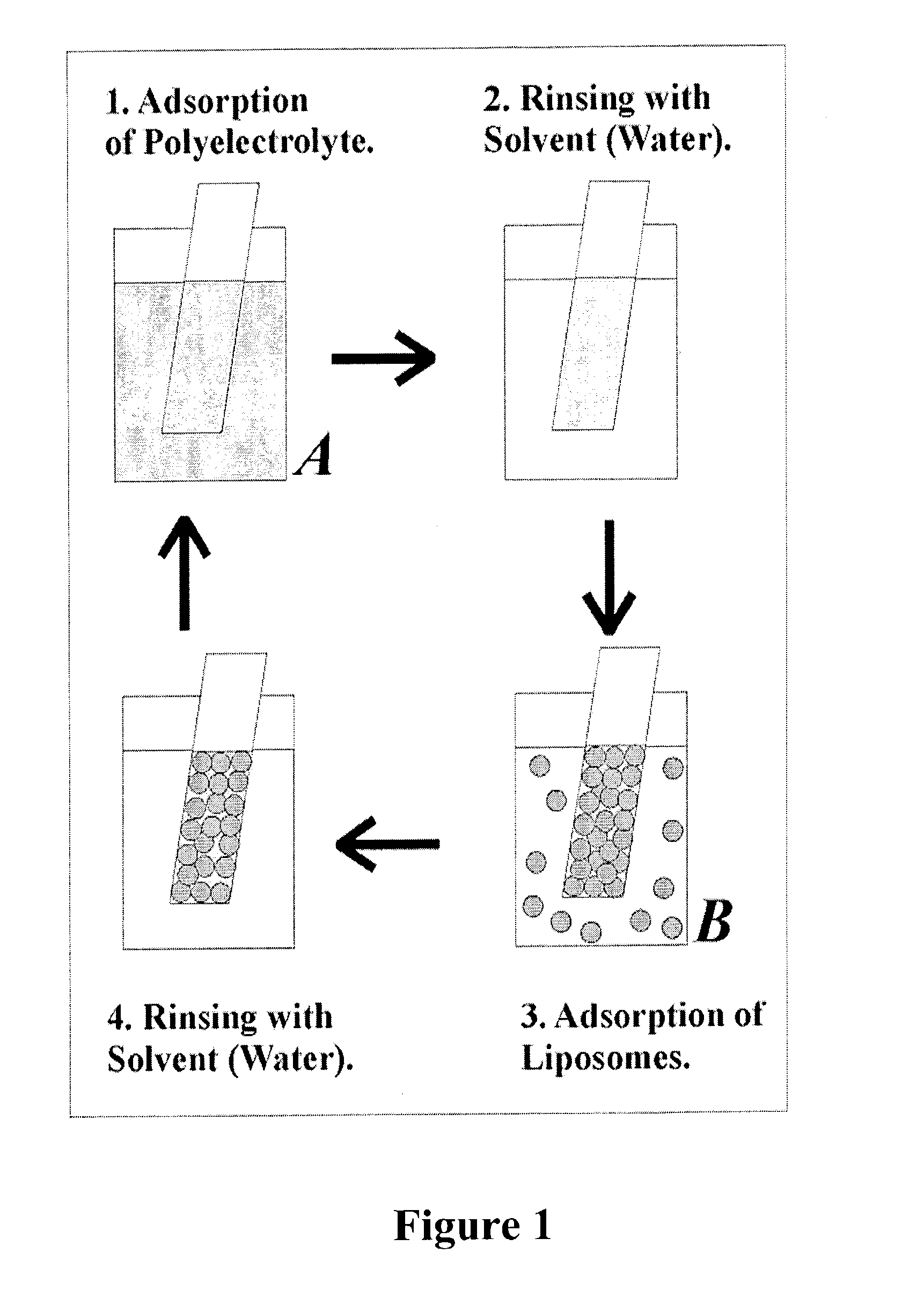Materials containing multiple layers of vesicles
a technology of vesicles and materials, applied in the field of materials containing multiple layers of vesicles, can solve the problems of low liposome entrapment volume, difficult immobilization of liposomes, inability to immobilize pre-formed liposomes, etc., and achieve the effect of high encapsulation capacity and cost-effectiveness
- Summary
- Abstract
- Description
- Claims
- Application Information
AI Technical Summary
Benefits of technology
Problems solved by technology
Method used
Image
Examples
example 1
Preparation of Liposomes
[0125]Liposomes with guest materials encapsulated therein are prepared, according to the general procedure for preparing liposomes recommended by Avanti Polar Lipids, Inc. The general elements of the procedure involve preparation of the lipid for hydration, hydration with agitation, and sizing to a homogeneous distribution of vesicles.
[0126]Preparation of lipid for hydration: POPC (1-Palmitoyl-2-Oleoyl-Sn-Glycero-3-Phosphocholine) and negatively charged POPG (1-Palmitoyl-2-Oleoyl-Sn-Glycero-3-[Phospho-rac-(1-Glycerol)] (POPC:POPG=7:3) are dissolved and mixed in chloroform. Once POPC and POPG are thoroughly mixed in an organic solvent, the solvent is removed to yield a lipid film. For small volumes of organic solvent (<1 mL), the solvent may be evaporated using a dry nitrogen or argon stream in a fume hood. For larger volumes, the organic solvent should be removed by rotary evaporation yielding a thin lipid film on the sides of a round bottom flask. The lipid ...
example 2
Preparation of Coatings Containing Multiple Layers of Liposomes on a Substrate
[0129]This example illustrates a typical LbL coating procedure for forming a coating containing multiple bilayers of liposome and a polyelectrolyte. Negatively charged liposome with Dextran-FITC encapsulated therein is prepared as described in Example 1. External Dextran-FITC (not encapsulated in liposome) is remove by dialysis using Spectra / Por Cellulose Ester membrane MWCO: 3,000,000. Because POPG is negatively charged, positively charged polyelectrolytes poly(diallyldimethylammonium chloride) (PDDA), or polyethyleneimine (PEI) are used in the LbL coating to form on quartz wafers LBL films containing bilayers [polyelectrolyte / liposome (FITC-Dextran)]n. Firstly, the quartz wafers are dipped into a polyelectrolyte solution (pH=4.5) for 7 minutes, and then in a liposome dispersion for 1 hour to form a bilayer of polyelectrolyte / liposome (FITC-Dextran). Such deposition cycle is repeated for n times to fabric...
example 3
Preparation of Liposome Stabilized by a Layer of Inorganic Silica
[0131]Negatively charged liposome with Dextran-FITC and Con-A-TMR encapsulated therein is prepared as described in Example 1. External Dextran-FITC and Con-A-TMR (not encapsulated in liposome) is remove by dialysis using Spectra / Por Cellulose Ester membrane MWCO: 3,000,000. After dialysis, the liposome concentration is estimated to be about 4.4×10−3 M.
[0132]Tetraethyl orthsilicate (TEOS) or tetramethyl orthosilicate (TMSO) is used in the modification of liposome. 0.5 ml of the above-prepared liposome dispersion is diluted to 3.0 ml and then is stirred vigorously at room temperature. Every three hours, about 5.2 μl of TEOS (or 4.1 μl of TMOS) is added into the liposome. A total of about 15.6 μl of TEOS (or about 14.2 μl of TMOS) is added into the diluted liposome dispersion. The molar ratio of TEOS (or TMOS) to liposome is about 32:1. The experiments are carried out at room temperature.
PUM
| Property | Measurement | Unit |
|---|---|---|
| diameters | aaaaa | aaaaa |
| diameter | aaaaa | aaaaa |
| size | aaaaa | aaaaa |
Abstract
Description
Claims
Application Information
 Login to View More
Login to View More - R&D
- Intellectual Property
- Life Sciences
- Materials
- Tech Scout
- Unparalleled Data Quality
- Higher Quality Content
- 60% Fewer Hallucinations
Browse by: Latest US Patents, China's latest patents, Technical Efficacy Thesaurus, Application Domain, Technology Topic, Popular Technical Reports.
© 2025 PatSnap. All rights reserved.Legal|Privacy policy|Modern Slavery Act Transparency Statement|Sitemap|About US| Contact US: help@patsnap.com



